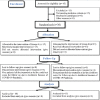Efficacy of Vyoshadi Guggulu and Shadushana Churna in the management of subclinical hypothyroidism: An open labelled randomized comparative pilot clinical trial
- PMID: 35370380
- PMCID: PMC8966764
- DOI: 10.4103/ayu.ayu_359_20
Efficacy of Vyoshadi Guggulu and Shadushana Churna in the management of subclinical hypothyroidism: An open labelled randomized comparative pilot clinical trial
Abstract
Background: Subclinical hypothyroidism (SCH) is defined as a mildly reduced function of the thyroid gland having elevated serum thyroid-stimulating hormone (TSH) level and normal concentrations of free tri-iodothyronine (FT3), free tetra-iodothyronine (FT4), T3 and T4. It occurs due to "Agnimandya" (low metabolic activity) at the systemic and cellular level. Vyoshadi Guggulu and Shadushana Churna having its effect on Agni (a root cause of SCH) are expected to prevent overt hypothyroidism and revert subclinical stage to euthyroid.
Aim: This study was planned to evaluate and compare the efficacy of Vyoshadi Guggulu and Shadushana Churna in the management of Dhatvagnimandya with special reference to sub-clinical hypothyroidism (SCH).
Materials and methods: Patients having serum TSH levels between 5 and 10 mlU/L and normal T3 and T4 values were diagnosed as SCH. A total of 30 patients were registered and randomly divided into two groups. In group A, patients were treated with Vyoshadi Guggulu (6 g), while in group B with Shadushana Churna (3 g) twice a day after lunch and dinner for 60 days. The assessment was done through changes in baseline and after treatment values of serum TSH level. Outcomes of the trial were analyzed using SigmaStat 4.0 version (trial) software. Student's paired t-test was used for within-group assessment, while unpaired t-test was used for intergroup comparison of the normally distributed parametric data.
Observations and results: Ten patients in group A and 11 in group B could complete the course of treatment. The findings revealed that therapy in group A and B showed decrease of 16.61% (P = 0.0494) and 26.29% (P = 0.0140) in serum TSH, respectively, 1.80% (P = 0.025) and 1.36% (P = 0.019) decrease in body mass index (BMI), respectively. The decrease in TSH and BMI was statistically significant in each group. In comparison, the decrease in serum TSH (P = 0.384) and BMI (P = 0.677) was statistically insignificant.
Conclusions: Vyoshadi Guggulu and Shadushana Churna are statistically equally effective to reduce serum TSH and BMI in the management of SCH.
Keywords: Agni; Dhatvagnimandya; Shadushana Churna; Vyoshadi Guggulu; subclinical hypothyroidism.
Copyright: © 2022 AYU (An International Quarterly Journal of Research in Ayurveda).
Conflict of interest statement
There are no conflicts of interest.
References
-
- Vij V, Chitnis P, Gupta VK. Evaluation of thyroid dysfunction among type 2 diabetic patients. Int J Pharm Bio Sci. 2012;2:150–5.
-
- Shekhar R, Chowdary NV, Das MC, Vidya D, Prabodh S. Prevalence of subclinical hypothyroidism in costal Andhra Pradesh. Biomed Res. 2011;22:471–4.
-
- Zulewski H, Mullar B, Exer P, Miserez AR, Stabb JJ. Estimation of tissue hypothyroidism by a new clinical score: Evaluation of patients with various grades of hypothyroidism and controls. J Clin Endocrinol Metab. 1997;82:771–6. - PubMed
-
- Shekhar R, Chowdary NV, Das MC, Vidya D, Prabodh S. Prevalence of subclinical hypothyroidism in coastal Andhra Pradesh. Biomed Res. 2011;22:471–44.
LinkOut - more resources
Full Text Sources
Miscellaneous

